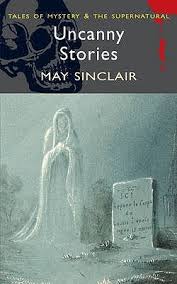
© Wordsworth Editions
Halloween is just ten days away. In the spirit of the season, I thought I’d repost some old entries about my favourite writers of spooky stories. I’ll begin with the impeccable May Sinclair, about whom I wrote this piece back in 2014.
I’ve just spent a few days reading Uncanny Stories, a collection of supernatural short stories by May Sinclair, a writer, poetess, literary critic and feminist who lived from 1863 to 1946. During her life, Sinclair was also a suffragette, a volunteer with an ambulance corps that helped wounded soldiers in Flanders during World War I and a member of the Society of Psychical Research. She was also the first person to use the term ‘stream of consciousness’ when describing the literary device made famous in James Joyce’s Ulysses. Tragically, her literary career ended in the late 1920s, thanks to the onset of Parkinson’s disease. By the time of her death a decade-and-a-half later she’d been forgotten by the literary lights she’d once fraternised with, who included the poet Ezra Pound.
Uncanny Stories was first published in 1923, a time when the most famous writer of ghost stories in British literature, Montague Rhodes James, was still alive. I’m a fan of M.R. James, but it annoys me when mainstream literary critics applaud James’s ghostly short stories for their ‘subtlety’ and ‘delicacy’ and ‘understatement’. If, for example, you’ve read James’s story Oh Whistle and I’ll Come to you my Lad, whose climax sees a mysterious, primordial thing taking physical form in the linen of the spare bed in the hero’s hotel room, like a self-assembling mummy, you’ll know it isn’t that subtle, delicate or understated. The story ends with an image that’s terrifyingly in-your-face. Much of the time, James doesn’t imply his supernatural terrors, as those critics claim he does. He shows them.
However, if you want proper subtlety, delicacy and understatment in your ghost stories, you should read the examples of the genre that May Sinclair pens in this collection.
There are ghosts in many of the tales in Uncanny Stories, but usually those ghosts serve to cast light on the psychology of the tales’ living protagonists. In The Token, the ghost is of a gentle, devoted woman who manifests herself only for as long as it takes her repressed, uptight husband to admit to something he never admitted while she was alive – that he loved her. Amusingly, Sinclair blames the husband’s problems on his Scottishness. He “suffers from being Scottish, so that if he has a feeling, he makes it a point of honour to pretend that he hasn’t it.”
A dead wife also figures in The Nature of the Evidence, wherein the widowed husband – “one of those bigoted materialists of the nineteenth-century type who believe that consciousness is a purely physiological function, and that when you’re dead, you’re dead” – remarries, not out of love but because he cold-bloodedly recognises his own sexual needs and resolves to satisfy them: “It’s a physical necessity… I shan’t marry the sort of woman who’ll expect anything more.” Needless to say, when the ghost of his first wife inconveniently manifests herself, Marston’s rationalism, and his second marriage, take an unexpected hit.
In If the Dead Knew the supernatural and psychological tension revolves around a mother-son relationship rather than a husband-wife one. Meanwhile, The Victim seems for much of its length to be a more traditional story wherein a servant murders his master and then becomes increasingly tormented by the murdered man’s spectre. But while the ghost in a conventional story would be out for revenge, the ghost here has more complex motives, as are revealed in the story’s unexpected denouement.
The Intercessor is the final and most impressive story in the collection, recounting a haunting by a child’s ghost that, gradually, leads the narrator to understand the emotional circumstances of the child’s still-living parents. The story’s intensity and the unforgiving wildness of its setting – the parents live beyond a field where “(a) wild plum tree stood half-naked on a hillock and pointed at the house”, and the house itself has “a bald gable-end pitched among the ash trees. It was black grey, like ash bark drenched with rain” – are worthy of Emily Bronte.
Not all these tales are about ghosts. Where their Fire is not Quenched and The Finding of the Absolute both speculate on what the after-life might be like. In one story the after-life is an idealistic one and in the other it’s positively hideous. The Flaw in the Crystal is about a female telepath who quietly uses her powers to cure other people of depression and instability. She’s horrified to discover that the suicidal madness of one of her ‘patients’ is leaking into her own mind and threatening to infect those other people she’s psychically linked with. The Flaw in the Crystal is the story I found hardest to get through, mainly because of its length. It’s 50 pages long but could’ve had the same impact with 20 pages less. Nonetheless, it contains some excellent writing and the scene where the madness begins to corrupt the heroine’s perceptions of the world around her is worthy of H.P. Lovecraft. The standard of the prose is considerably higher than Lovecraft’s, though.
A sad fact of life – and death – is that when people die, they usually leave unfinished business with those around them. The supernatural aspects of the stories here allow their protagonists, living and dead, a second chance to resolve their business with one another. Subtle rather than frightening, and not hell-bent on wreaking revenge, the worst that can be said about May Sinclair’s phantoms is that they’re unnerving in their determination to sort things out.

From wikipedia.org
